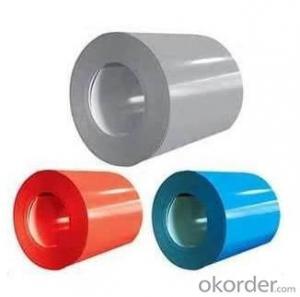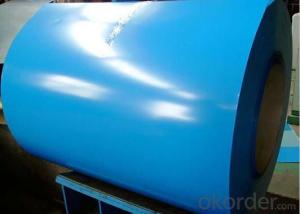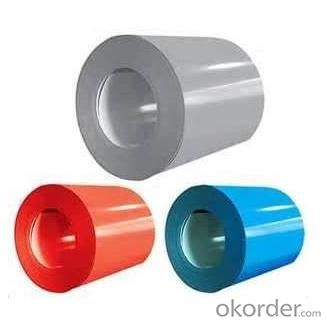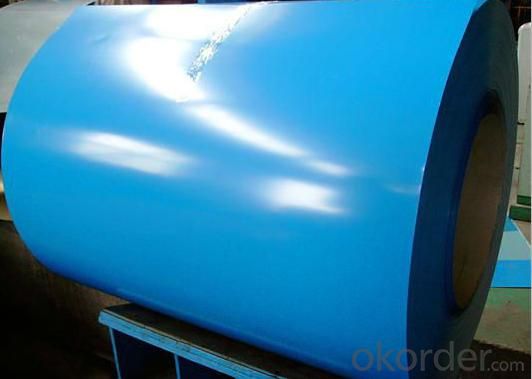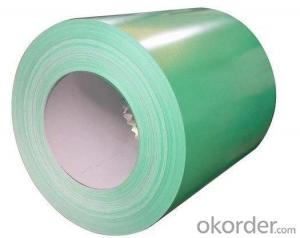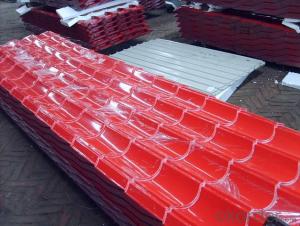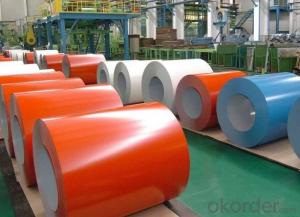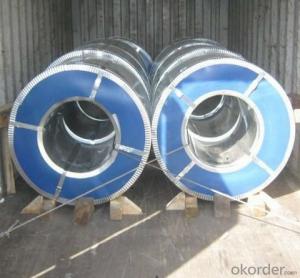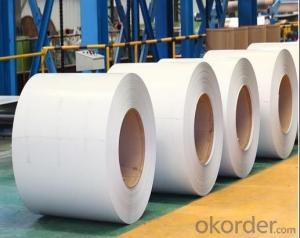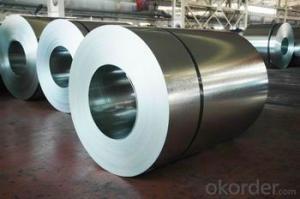Color Coated Zinc Steel Coil of Building Materials
- Loading Port:
- Shanghai
- Payment Terms:
- TT OR LC
- Min Order Qty:
- 25 m.t.
- Supply Capability:
- 20000 m.t./month
OKorder Service Pledge
OKorder Financial Service
You Might Also Like
Basic Info.
Surface Treatment:Coated
Grade:Galvanized or Gavalume
Width:914, 1000, 1200, 1219, 1220, 1250
Treatment:Galvanized or Gavalume
Color:Ral Standard, or Buyer′s Sample Color
Zinc Coating:40-150GSM
Length:up to The Thickness
Base Material:Steel
Lacquer:Top Side15-25 Micro, Back Side 5 Micro
Surface:Passivation Unoiled Free Spangle Passivated
Export Markets:Global
Additional Info.
Trademark:STW or OEM
Packing:Export Seaworthy Packing
Standard:JIS G3312 / CGCC
Production Capacity:20000 Metric Tons/Month
Specifications;
1. Aluzinc coating mass: 30g-275g/sqm
2. Coil weight:4-6 tons per coil
3. Edge treatment: Mill edge or cut edge.
4. Technical treatment: Bright annealed, flatting, cold harden.
5. Surface treatment: Annealed, bright finish, dull/bright finish, slit edge.
6. Spangle: Normal/small/big/zero spangle.
7. Delivery terms: FOB / C&R / CIF
8. Supply Ability: 20000MT/month
9. Application: The construction industry: The roof structure, keel, grill, Clapboard, ceilings, fire shutter doors, etc; The light industry, the Automobile, agriculture, animal husbandry, fishery, casing of household Electronic application, civilian smoke stack, etc.
10. Delivery time: Within 30 days after the receipt of L/C or Signed the contract or according to customer's requirement.
Special design available according to requirement; Anti-corrosion And high-temperature resistant with black painting; All the production process Are made under the ISO9001: 2000 strictly
| Zinc Coating | 60-275g( as required) |
| Thickness Range | 0.14-1.5mm |
| Coil Inner Diameter | 508mm |
| Coil weight | 3-5MT(as required) |
| Surface | Regular/mini/zero spangle, chromated, skin pass, dry etc. |
| Width range | 600-1250mm(900mm, 1215mm, 1250mm, 1000mm the most common) |
| Applications | With excellent cold bending molded manufacturablity, good decoration effect, strong anti-corrosion ability, galvanized steel coils and sheets are also pollution-free and easily recycled. Accordingly, they can be used as final products and basic plates of color coated steel coils and widely applied in construction, home appliances, decoration, ect. |
- Q: why do you need to heat steel when hardening, molecules etc etc
- Gary is right, but maybe I can simplify it. It's very complex..... When you heat (hardenable) steel the carbon and iron form crystalline structures. Martensite and Austenite are most prominent, but there are others. Those are the hard crystals. When you quench it, those structures don't have time to dissolve as they would with slow cooling, so you freeze the crystalline structure in that state. Since that is too hard for most things, you temper it. Heating to a certain temp lets ~some~ of the crystals dissolve away. Annealing is heating and letting it cool slowly, so those structures will break up back into carbon and iron, leaving the steel soft. It's like a little atomic machine - crystals form, dissolve away, form again, with heat. It's waaaaay deeper than just that in detail, but that's the gist of it.
- Q: Can steel coils be stored vertically?
- Yes, steel coils can be stored vertically.
- Q: What are the common defects in steel coil surface finishes?
- Common defects in steel coil surface finishes include scratches, pits, roll marks, stains, and unevenness. These defects can be caused by various factors such as improper handling, processing issues, or equipment malfunction. These surface defects affect the aesthetics and quality of the steel coil, making it unsuitable for certain applications or requiring additional processing to rectify the defects.
- Q: Why buy recycled steel and from where to buy?
- Where you buy all your steel. The recycled and new steel are indistinguishable from each other. You won't recognize the one from the other. Same thing with glass. A certain percentage must be used glass, to enhance the quality of the total batch. Peace.
- Q: Can steel coils be coated with epoxy?
- Yes, steel coils can be coated with epoxy. Epoxy coatings are commonly used to protect steel from corrosion and provide a durable finish.
- Q: What are the dimensions of steel coils used in the structural component industry?
- The dimensions of steel coils used in the structural component industry can vary depending on the specific application and requirements. However, some common dimensions for steel coils used in this industry include a width ranging from 600mm to 2000mm and a thickness ranging from 0.25mm to 10mm. The weight of these coils can also vary, typically ranging from a few kilograms to several tonnes. Additionally, the length of the steel coils can be customized to meet the specific needs of the structural component industry, with common lengths being 2000mm, 2500mm, and 3000mm. It is important to note that these dimensions are not exhaustive and can vary based on the specific product and manufacturer.
- Q: Already on my team is Empoleon lvl 82Heatran lvl 74Scizor lvl 34Magnezone lvl 38What other steel types should I choose?
- skarmory ferathorn lucario dialga metagross
- Q: I am doing a experiment on mild steel soaked in sodium chlorideanyone can enlighten me about the effect of the sodium chloride in engineering term ?The mild steel specimen which I soaked in the sodium chloride has orange rust on it
- The mild steel contains a lot of Iron. The NaCl solution quickly attacks the iron content and forms rust. Over time, the solution may also cause what is called 'Chloride Cracking' of the steel. Pitting corrosion of stainless steel due to chlorides would certainly produce a rust-colored product. Passivation can be used to maintain a good corrosion resistant surface of stainless steel process vessel. There are many commercial products for this purpose. In the pharmaceutical industry, this process is often called derouging, that is to remove the buildup of iron oxides on the stainless steel process surfaces
- Q: How are steel coils used in the production of steel washers?
- Steel coils are used in the production of steel washers by being uncoiled and fed into a stamping machine. The machine then cuts and shapes the steel into individual washer blanks. These blanks are then further processed and finished to create the final steel washers.
- Q: How are steel coils transported internationally?
- Typically, steel coils are shipped internationally by sea due to their heavy and bulky nature, which makes air transportation impractical. The most common method involves using specialized shipping containers called flatracks or open-top containers, which allow for easy loading and unloading onto vessels. Before being transported, the steel coils are typically securely strapped or banded together to prevent movement or damage during transit. Cranes or forklifts are then used to load the coils onto the flatracks or open-top containers. Careful placement and securing of the coils onto the containers ensure stability and prevent shifting during the journey. Once loaded, the containers are sealed and taken to the nearest port, where they are loaded onto cargo ships designed specifically for heavy and oversized cargo. These ships are equipped with specialized handling equipment like cranes and ramps to facilitate container handling. During the journey, the cargo ships adhere to predetermined shipping routes to reach the destination port. The duration of the journey depends on the distance between the origin and destination ports. Since steel coils are typically transported in large quantities, multiple containers may be loaded onto a single ship. Upon arrival at the destination port, cranes or ramps are used to unload the containers from the cargo ship. The steel coils are then carefully removed from the containers and transported to their final destination, which may involve further transportation by road or rail. Throughout the transportation process, it is crucial to adequately protect the steel coils from moisture, corrosion, and other potential damages. Special attention is given to handling and stowage to minimize the risk of structural damage or deformation. In conclusion, specialized shipping containers are utilized to transport steel coils internationally by sea. The coils are securely loaded onto flatracks or open-top containers and transported by cargo ships to the destination port. Proper handling and stowage techniques are employed to ensure the safe and secure transportation of the steel coils.
Send your message to us
Color Coated Zinc Steel Coil of Building Materials
- Loading Port:
- Shanghai
- Payment Terms:
- TT OR LC
- Min Order Qty:
- 25 m.t.
- Supply Capability:
- 20000 m.t./month
OKorder Service Pledge
OKorder Financial Service
Similar products
Hot products
Hot Searches
Related keywords
